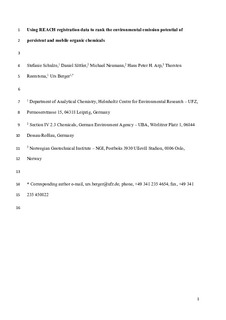| dc.contributor.author | Schulze, Stefanie | |
| dc.contributor.author | Sättler, Daniel | |
| dc.contributor.author | Neumann, Michael | |
| dc.contributor.author | Arp, Hans Petter Heinrich | |
| dc.contributor.author | Reemtsma, Thorsten | |
| dc.contributor.author | Berger, Urs | |
| dc.date.accessioned | 2018-02-13T10:38:08Z | |
| dc.date.available | 2018-02-13T10:38:08Z | |
| dc.date.created | 2018-01-18T15:29:54Z | |
| dc.date.issued | 2018 | |
| dc.identifier.citation | Science of the Total Environment. 2018, 625 1122-1128. | nb_NO |
| dc.identifier.issn | 0048-9697 | |
| dc.identifier.uri | http://hdl.handle.net/11250/2484327 | |
| dc.description.abstract | Organic chemicals that are persistent and mobile in the aquatic environment exhibit a hazard to contaminate drinking water resources. In this study an emission score model was developed to rank the potential of substances registered under the REACH legislation to be emitted into the environment. It was applied to a list of 2167 REACH registered substances thatwere previously identified to be persistent andmobile organic chemicals (PMOCs) in groundwater or to be hydrolyzed to form transformation products fulfilling the PMOC criteria. The emission score model is based on the tonnage placed on the European market and on seven emission-related use characteristics (high release to environment, wide dispersive use, intermediate use, closed system use, professional use, consumer use, and substance in article), reported in the companies' registrations under REACH. Applying the model resulted in a list of 1110 substances (936 PMOCs and 174 precursors to PMOCs) that were estimated to be released into the environment,while 1054 substances had indicators of negligible environmental emissions and 3 substances could not be evaluated due to severe data gaps. The 936 PMOCs and the 174 precursors were ranked in two lists with regard to their emission potential. The model was shown to be fit for purpose in terms of suggesting and prioritizing substances for scientific investigations with a focus on environmental water quality. Though targeted for PMOCs, the presented scoring systemis illustrative of how REACH registration data can be used to assess the emission potential of various substances. | nb_NO |
| dc.language.iso | eng | nb_NO |
| dc.title | Using REACH registration data to rank the environmental emission potential of persistent and mobile organic chemicals | nb_NO |
| dc.type | Journal article | nb_NO |
| dc.type | Peer reviewed | nb_NO |
| dc.description.version | acceptedVersion | nb_NO |
| dc.source.pagenumber | 1122-1128 | nb_NO |
| dc.source.volume | 625 | nb_NO |
| dc.source.journal | Science of the Total Environment | nb_NO |
| dc.identifier.doi | 10.1016/j.scitotenv.2017.12.305 | |
| dc.identifier.cristin | 1546596 | |
| cristin.unitcode | 7452,5,1,0 | |
| cristin.unitname | Vann og ressurser | |
| cristin.ispublished | true | |
| cristin.fulltext | postprint | |
| cristin.qualitycode | 2 | |
